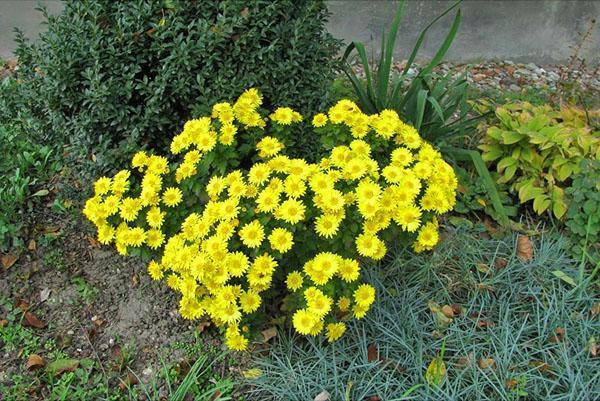Growing perennial chrysanthemums
 Korean chrysanthemums are unpretentious perennial flowers. The first variety of this subspecies was obtained at the end of the twentieth century by crossing the "Siberian chrysanthemum", which was brought to Russia from Korea and various varieties of large-flowered chrysanthemum. The first hybrid varieties of bush chrysanthemums were vulnerable to fungal diseases. Breeders, in an attempt to get rid of this shortcoming, crossed wild varieties with bred hybrids. This influenced the size of the flowers, and the first small-flowered bush chrysanthemums appeared.
Korean chrysanthemums are unpretentious perennial flowers. The first variety of this subspecies was obtained at the end of the twentieth century by crossing the "Siberian chrysanthemum", which was brought to Russia from Korea and various varieties of large-flowered chrysanthemum. The first hybrid varieties of bush chrysanthemums were vulnerable to fungal diseases. Breeders, in an attempt to get rid of this shortcoming, crossed wild varieties with bred hybrids. This influenced the size of the flowers, and the first small-flowered bush chrysanthemums appeared.
Small-flowered chrysanthemums
Today everyone calls "Korean" small-flowered chrysanthemums... There are over 400 varieties of hybrid perennial flowers. They all differ in terms of flowering time and color. By the timing of flowering, bush chrysanthemums are divided into early, mid-late, and late. Early chrysanthemums bloom in mid-May - early June. Medium late - at the end of August. Late - in early September. All bush chrysanthemums do not tolerate spring stagnation of water or the proximity of groundwater, so it is better to plant chrysanthemums on a hill.
Large-flowered chrysanthemums
Some varieties of large-flowered chrysanthemums can be grown in central Russia. The homeland of large-flowered chrysanthemums is India. It was from there that they spread to China and Japan. These perennial flowers take root well in sandy or sandy loam soil. The hot and dry climate is most suitable for large-flowered chrysanthemums. These flowers, like spray chrysanthemums, do not tolerate stagnant water. The buds of large-flowered chrysanthemums die already at 0ABOUTC. They turn black and fall off without blooming.
In central Russia, large-flowered chrysanthemums can be grown as annual plants. Before the first frost, the peduncles must be cut, the plants must be dug up and transplanted into pots. To avoid stagnant water, drainage is poured at the bottom of the pot. After transplanting chrysanthemums, the soil in the pot is mulched to retain moisture. Pots with large-flowered chrysanthemum are transferred to a room with a temperature of +6ABOUTC - (+ 8ABOUTFROM). After planting chrysanthemums in the spring back into the open ground, the stem is cut at the root. This stimulates the formation of a new basal shoot.
General recommendations for growing chrysanthemums
In April, apply a complex mineral fertilizer with a high content of potassium and phosphorus to the soil. In July, you can apply nitrogen fertilizers to the soil.
Do not plant chrysanthemums in shade or partial shade. Transplant chrysanthemums to a new place every 2-3 years or add humus to the soil.